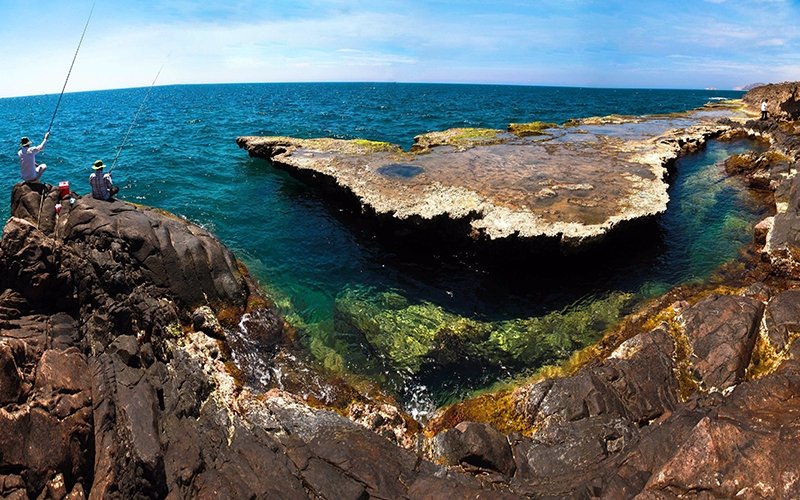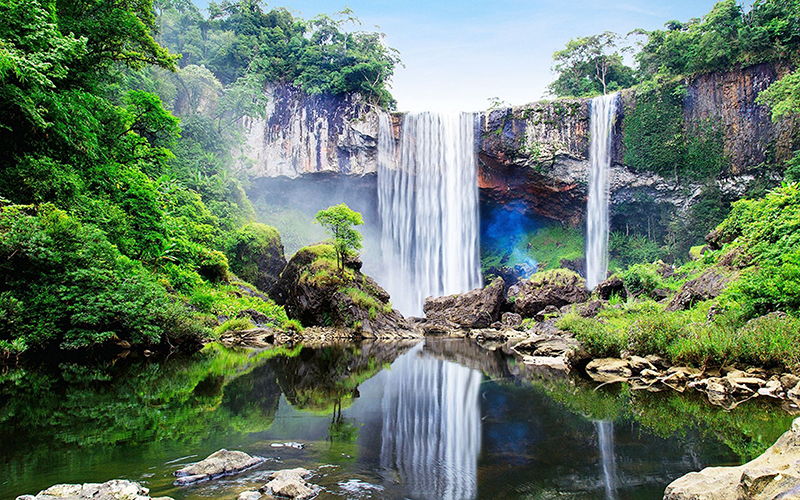Vietnam’s biosphere reserves Nui Chua (Ninh Thuan Province) and Kon Ha Nung Plateau (Gia Lai Province) were officially recognised by the United Nations Educational, Scientific and Cultural Organisation (UNESCO) as Global Biosphere Reserves on September 15. This provides great joy for Vietnam, but it also poses many problems in terms of preserving and promoting the values of these two biosphere reserves.

Rai Cave in the tourism clusters of Nui Chua World Biosphere Reserve. (Photo: VNA)
Nui Chua Biosphere Reserve, located in the two districts of Ninh Hai and Thuan Bac (Ninh Thuan Province), is a natural population, with land, sea and the area inside the buffer zone (forest, sea and semi-desert), more than 31,000 hectares wide. Kon Ha Nung Biosphere Reserve is spread over the districts of Dak Doa, Mang Yang, Kbang, Chu Pah, Dak Po and An Khe Town (Gia Lai Province), with an area of 413,511.67 hectares, representing the system forest ecology in the Central Highlands.
Nui Chua Biosphere Reserve is a structure of natural landscapes distributed on a mountain complex close to the coast, creating many beautiful landscapes in the South-Central Coast, which is the only standard sample of the typical and unique dry forest ecosystem in Vietnam and Southeast Asia.
Here, there are six types of forests distributed from low to high, with 1,514 species of plants and 763 species of animals. Of which, there are 54 species of plants and 46 species of rare animals listed in the Vietnam Red Data Book and the World Red List. Nui Chua is also home to the black shanked douc langurs (pygathrix nigripes), a primate species listed in the Red List that is being preserved and developed. In particular, there are 48 endangered animal species according to the Vietnam Red Data Book and 34 globally endangered species still distributed here.
Nui Chua has rare marine flora and fauna, with a large coral population of more than 350 species; it is a rare place on the mainland, where every year there are three species of turtles that come to breed and are under strict protection: the hawksbill sea turtle (Eretmochelys imbricata), the pacific ridley sea turtle (Lepidochelys olivacea), and the green sea turtle (Chelonia mydas).
Kon Ha Nung Biosphere Reserve consists of three regions: the core zone covers an area of 57,589 hectares, including Kon Ka Kinh National Park and Kon Chu Rang Nature Reserve; the buffer zone has an area of 152,009 hectares; and the transition zone has an area of 206,211 hectares. Kon Ha Nung is also known as the Roof of Indochina with the highest peak rising more than 1,700 metres.
This is an area with closed subtropical humid evergreen forest ecosystem which remains relatively intact. There are many unique, outstanding, unique features. The fauna and flora in the core zone of Kon Ka Kinh National Park are diverse and abundant with about 1,754 species of higher plants; 91 species of lower plants; 87 species of animals; 326 species of birds; 77 species of reptiles, and many rare and endangered mammal species. In particular, there are some recently discovered endemic species such as chestnut-eared laughingthrush (Garrulax konkakinhensis) and the grey-shanked douc langur (Pygathrix cinerea), which are endemic primates of Vietnam. Kon Ha Nung plateau also possesses many beautiful waterfall systems, which make it an extremely attractive eco-tourism destination.
UNESCO's recognition of Kon Ha Nung Biosphere Reserve as a global biosphere reserve will be an important condition for Gia Lai Province to preserve the landscape and ecosystem in this area; opening up opportunities for people to develop an environment-friendly economy in parallel with preserving the national cultural identity. At the same time, this is also the basis for Gia Lai Province to plan and delineate strict conservation areas, conservation areas and areas permitted for investment and development at different levels.
On the basis of promoting community participation in forest management and protection activities and benefit sharing from forests, the Gia Lai provincial authorities have identified the corridor connecting Kon Ka Kinh National Park and Kon Chu Rang Nature Reserve as a pilot area of this type. Accordingly, the province is focusing on supporting and creating conditions for local communities to participate in forest conservation and restoration through the development of local sustainable agriculture and forestry models.

K50 Waterfall, a masterpiece of nature in Kon Ha Nung Global Biosphere Reserve (Gia Lai). Photo: Phan Nguyen
According to Ngo Van Thang, Deputy Director of Kon Ka Kinh National Park, participating in forest protection contracts has helped households achieve stable income, contributed to improving their lives, and more importantly, deforestation for farming is now almost non-existent.
Toang, a resident contracted to manage and protect the forest in De KJieng Village, Ayun Commune, Mang Yang District, Gia Lai Province, said that in the past, his family life as well as that of many households in the village was very difficult because of having no job; just depending on the fields, they didn’t have a steady income. Since joining the contract of forest land, in addition to the income from the contract, the family also has an additional source of income from by-products such as bamboo shoots and mushrooms, so their life has become more stable.
The Kon Ka Kinh National Park Management Board attaches great importance to selecting specialised forces for forest protection, with the core being from local people. Byut from De KJieng Village, who has been the leader of forest protection from 2015 until now, has been contracted to protect nearly 2,000 hectares of forest. Thanks to his good work in forest protection, at the end of 2019, he was signed by the Kon Ka Kinh National Park Management Board to become a full-time officer in charge of forest protection. Byut happily said: "I am aware that I have to raise the responsibility for myself as well as the people in the village to manage and protect the forest".
In recent years, Ninh Thuan Province has also always encouraged people living in the buffer zone to actively participate in protecting forests and rare plant and animal species. At Nui Chua Biosphere Reserve, there are three teams of volunteers to protect sea turtles, corals, and seagrasses (from 15 to 20 members per team). Nguyen Thanh Danh, Team Leader of Volunteers to Protect Sea Turtles, shared that in the past, people living in the buffer zone used to go to the forest to exploit resources and catch sea turtles, but for nearly ten years, many people have quit their jobs and are the leading members in preventing acts of harming the resources of Nui Chua area.
Cao Van Giac, leader of sustainable livelihood model in Da Hang Village, Vinh Hai Commune, Ninh Hai District (Ninh Thuan Province) said that when Vinh Hai Commune's people heard that Nui Chua Biosphere Reserve was recognised as a Global Biosphere Reserve, it made them very happy and they look forward to receiving a contract to protect the forest with a larger area, with determination to preserve the best ecological environment to serve tourism development in a new position.".
Chairman of the People's Committee of Ninh Hai District (Ninh Thuan Province) Nguyen Thanh Phu said "In the near future, this area will develop eco-tourism, certainly attracting a large number of domestic and foreign tourists." In early 2021, the District People's Committee and Anh Phat Investment, Construction and Trading Corporation signed a cooperation agreement to develop eco-tourism, resorts, and entertainment. In the near future, this place will shape both community tourism areas and strict conservation areas.
With the advantage of geographical location near three major tourist centres in the southern, namely Da Lat, Nha Trang and Ho Chi Minh City, Nui Chua Biosphere Reserve is very convenient for the development of eco-tourism. Ninh Thuan soon developed a master plan for both core and buffer zones, in order to harmoniously combine conservation and sustainable development for tourism.
The planning will be the basis for delimiting strict conservation areas, areas for conservation and areas for investment and development at different levels of permission; including developing eco-tourism, calling for investment in conservation, tourism and leasing the forest environment to develop permitting activities.
Pham Van Hau, Permanent Deputy Secretary of Ninh Thuan Provincial Party Committee said that it has been very emotional to learn that Nui Chua Biosphere Reserve has been recognised by UNESCO as a Global Biosphere Reserve. But at the same time, the province is more and more aware of its responsibility to protect and exploit the invaluable assets of humanity.
Vice Chairman of Gia Lai Provincial People's Committee Kpa Thuyen emphasised that after being recognised as a Global Biosphere Reserve, Gia Lai has committed itself to strictly implementing UNESCO's regulations in order to ensure the criteria and functions of a biosphere reserve. Kon Ha Nung Biosphere Reserve is becoming a model of sustainable socio-economic development of the locality, harmonious connecting between biodiversity conservation and preservation of ethnic cultural identities, between economic development and environmental protection.
Quang Duy - Nguyen Trung - Phan Hoa
Translated by NDO